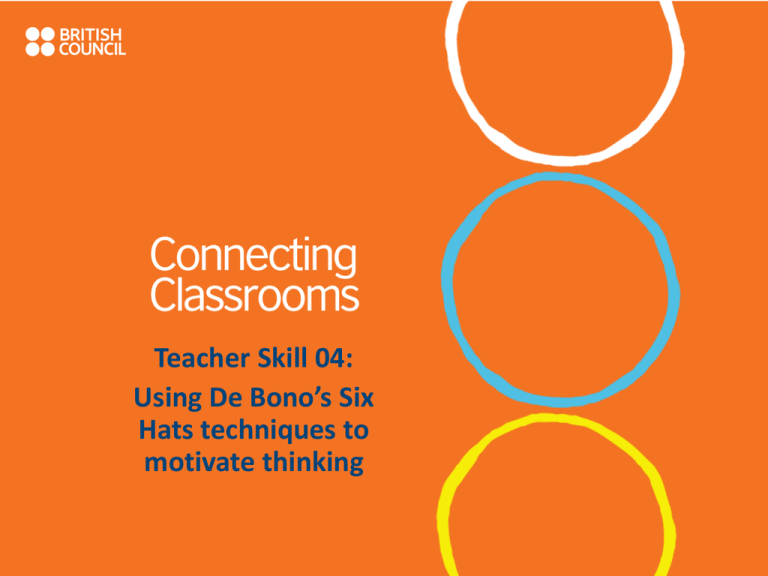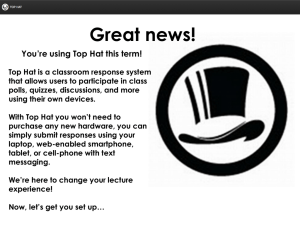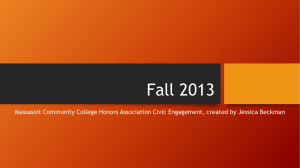Skill 04_ De Bono`s Hats
advertisement

Teacher Skill 04: Using De Bono’s Six Hats techniques to motivate thinking Teacher Skill 04: Using De Bono’s Six Hats techniques to motivate thinking OBJECTIVES 1. 2. What each of the 6 hats represents Understanding how the 6 hats: – Encourages critical thinking. – Explores ideas from a variety of viewpoints. – Add depth to learning. Edward De Bono Six Thinking Hats An aid to creative thinking ‘You can analyse the past, but you can design the future.’ Edward de Bono Thinking in hats (Edward de Bono) • To aid creative thinking Edward de Bono came up with six notional hats that can be put on and taken off easily. • The hats are designed to indicate a role or mode of thinking. • It is based on the principle of parallel thinking. The white hat (informative) • The information seeking hat. • What are the facts? • What information is available? What is relevant? • When wearing the white hat we are neutral in our thinking. The red hat (intuitive) • What do you feel about the suggestion? • What are your gut reactions? • What intuitions do you have? • Don’t think too long or too hard. The black hat (cautious) • The caution hat. • In the black hat a thinker points out errors or pitfalls. • What are the risks or dangers involved? • Identifies difficulties and problems. The yellow hat (constructive) • The sunshine hat. • It is positive and constructive. • It is about effectiveness and getting a job done. • What are the benefits, the advantages? The green hat (creative) • This is the creative mode of thinking. • Green represents growth and movement. • In the green hat we look to new ideas and solutions. • Lateral thinking wears a green hat. The blue hat (reflective) • The control hat, organising thinking itself. • Sets the focus, calls for the use of other hats. • Monitors and reflects on the thinking processes used. • Blue is for planning. Six thinking hats • White hat—pure facts, figures and objective information. • Red hat—emotions and feelings; hunches and intuition. • Black hat—devil’s advocate; logical negative judgment; why it won’t work. • Yellow hat—sunshine, brightness and optimism; positive constructive thought. • Green hat—fertile, creative, new ideas, movement, provocation. • Blue hat—cool and controlled; rule over other hats. Q1. Scenario 1 • All students should be given 60 Riyals (or £10) every week to attend school. • Apply different hat thinking to this suggestion. • Don’t worry if you agree or disagree with the statement. Examples • By the end the year, they will have received 1800 Riyals (£300). (white hat) • I feel that they will waste the money on things not needed. (red hat) • Giving money to them will allow them to become better adults as they will learn about money management. (yellow and green hats) • Schools will lose money for no reason. (black hat) • Students could pool money and buy a new computer for their classroom. (green hat) Q2. Scenario 2 • Teachers using new Super Teacher methodologies should have a 30% pay raise. • Apply different hat thinking to this suggestion. • Don’t worry if you agree or disagree with the statement. Q3. Scenario 3 • Cars should be banned from the city centre. • Apply different hat thinking to this suggestion. • Don’t worry if you agree or disagree with the statement. Q4. Scenario 4 • Computers are essential for good education. • Apply different hat thinking to this suggestion. • Don’t worry if you agree or disagree with the statement. Activity 1 C A B A B C Connect each of the pairs with a line. Stay in the box and do not cross over any line. (So you must connect A to A, B to B and C to C). To finish…….. ‘Perhaps the most important benefit from teaching thinking is the increase in self-esteem and self-confidence of those taught. A youngster taught thinking feels in control of his of her life-instead of feeling like a cork carried along by a stream of life and controlled by the currents.’ Edward de Bono. Plenary What action will you now take based on what you have learnt from Teacher Skill 4?











